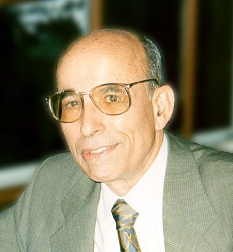
He specializes in a branch of science known as photochemistry, in which the interactions between atoms, small molecules and light are analyzed. Now Jack Saltiel, a veteran professor of chemistry and biochemistry at Florida State University, is being recognized for decades of pioneering research in his field.
Saltiel, a member of the FSU faculty since 1965, has been elected a fellow of the Inter-American Photochemical Society (I-APS), the pre-eminent organization for the promotion of, and dissemination of knowledge about, photochemistry throughout North, Central and South America. A plaque recently presented to Saltiel states that he was "elected I-APS Fellow for lifetime achievements in and contributions to the photochemical sciences."
"As a scientist, I have found fulfillment in scientific discovery and in the sharing of new knowledge with the scientific community, which over time becomes a scientific family," Saltiel said. "To be recognized for lifetime achievement by the Inter-American Photochemical Society (the members of that family who are experts in my area of research) is a gratifying echo and a stimulus."
A recent focus of Saltiel’s research has been the light-induced reactions that lead to the formation of vitamin D in the skin and in industrial reactions. (Vitamin D plays a significant role in calcium transport, and one of the outcomes of vitamin D deficiency is rickets, a softening of the bones in children that can lead to fractures and deformity.) Related to his research, Saltiel was issued a patent on "The Photochemical Synthesis of Vitamin Ds" in 2007. (See www.freepatentsonline.com/7211172.html for a description of that patent.)
Saltiel also is recognized as the world’s foremost expert on cis-trans photoisomerization, the key chemical process in vision. One of the simplest processes for converting light into mechanical motion at the atomic scale, cis-trans photoisomerization is widely used in photoactive proteins such as those found in the retina of the eye.
"The act of ‘seeing’ starts with light energy being used in the eye to cause the rearrangement of a large molecule that is attached to and is surrounded by a protein," Saltiel said. "In its simplest form, that rearrangement requires freedom of motion within a large volume of empty space. Because the protein does not offer much empty space, people have thought of and looked for other ways in which the same rearrangement might occur without as large a free-volume requirement. One of the ways of economizing volume demand was proposed in 1976 and involves simultaneous motion of two parts of the molecule in a way resembling the motion of two pedals of a bicycle or a crankshaft. Thirty years later, we discovered that such a ‘bicycle pedal’ process actually takes place in molecules that are similar to the one that triggers the vision process. Our discovery lends credibility to the 1976 proposal."
In addition to his prolific scientific career, Saltiel has made his mark as an educator. In addition to numerous graduate students and postdoctoral fellows, he has mentored more than 80 undergraduates in his chemistry lab during his 43-year tenure at FSU. Inspired by his teaching, many of these students went on to pursue successful careers in chemistry. One former undergraduate in particular who became a scientist and educator of great distinction is Mark Wrighton, who taught chemistry at the Massachusetts Institute of Technology for 23 years prior to being named chancellor of Washington University in St. Louis. Wrighton cites the pivotal influence of Saltiel in persuading him to pursue a career in science.
Saltiel is one of only two new fellows elected by the I-APS for 2008. He becomes just the second FSU faculty member to receive the honor; Michael Kasha, a professor emeritus in the Department of Chemistry and Biochemistry, was elected an I-APS fellow in 1995.




